You also want an ePaper? Increase the reach of your titles
YUMPU automatically turns print PDFs into web optimized ePapers that Google loves.
Online & Mobile12 31. Power in a desert. Charging mobile phones in the desert is a realchallenge. Plugging onto the car battery is the only available option. AlJazeera reporter May Welsh.Powering the Arabicrevolutions2. Moving around with big cameras during revolutions is impossible.Al Jazeera has switched to mobile phones instead.3. News in pocket size. Safdar Mustafa is Head of Mobile Media at AlJazeera. Photo: Helge Skodvin4. Al Jazeera has made a lot of video content captured viamobile available in an open creative <strong>com</strong>mons repository.– It’s an integral part of our philosophy, says Safdar Mustafa.By Anders W. Hagen / Story reprinted with the permission of The Norwegian Financial DailyNO MATTER WHAT. When Al Jazeera’sjournalists find it to dangerous to bring thecamera to document riots and clashes withsecurity forces, they bring out their mobilephone. And continue reporting. “It all boilsdown to avoiding restrictions on how eventsare documented. It’s either nothing, orcontent captured with your mobile. Clearlythe most important is to show what’s goingon, says Safdar Mustafa, Head of MobileMedia at Al Jazeera Network. During themany revolutions in the Middle East overA bomb went off, with our reporterson-site. Without a camera, he grabbedhis phone and filmed the destruction.Then he sent the material straight backto the news desk.the last couple of months, the Arabic andEnglish speaking news organization hasyet again demonstrated its leading positionin the global media landscape. Mustafarecently held a keynote session in Bergenat an event hosted by <strong>Vizrt</strong>.Censored and arrested. To Al Jazeera, the mobile phone hasbe<strong>com</strong>e an important tool in order to avoid censorship and dangerwhen reporting from countries such as Egypt, Tunisia and Bahrainwhere violent clashes and oppressive regimes make life extremelydifficult for journalists. “In regions where governments strike hardagainst news conveyers, the mobile plays an important part ingathering content. In some countries – at certain times – bringing acamera is extremely difficult,” says Mustafa.His employer has plenty of experience dealing with attemptsto enforce censorship and make arrests. Egypt’s former presidentHosni Mubarak decided to have armed forces close down the AlJazeera headquarters in his country, and reporters were not allowedto travel to several Arabic countries,including Syria.A Mobile Solution. By replacingthe camera with a mobile,Al Jazeera now much moreeasily get footage and accessto areas of conflict, withoutfear of having their equipmentconfiscated.Mustafa himself was partof the first tests using a mobilecamera a few years back. Byplacing a Nokia N95 on thedashboard of his Jeep, he drovearound the streets of Doha, Qatar. When returning, his colleagueswere impressed by the quality.“Most mobiles have what we need: a camera, support for transmittingdata at high speeds and GPS localization. We did two tests.One was a planned trip documenting through the Sahara in Maliand Niger, where the reporter followed a group of rebels aroundclosely. For us it was of paramount importance to quickly documenthappenings without bringing the big camera, says Mustafa.“The second “test” was the real deal – breaking news. A bombwent off in Chad, and one of our reporters was on-site – but withouta camera. He grabbed his phone and filmed the destruction andreactions afterwards. He held his mobile in the one hand and hispress card in the other while recording. Then he sent the materialstraight to the news desk from his mobile,” Mustafa explainseagerly.“During the demonstrations at Tahrir Square in Cairo in Egypt, itwas very challenging to report from the ground,” Mustada says.“There were security forces of rebels, all dressed in civilianclothes – <strong>com</strong>plete chaos. Walking around with big cameras wouldbe dangerous, not to mention bringing lots of heavy equipment.”A Funeral in Bahrain. Another scenario unfolded when one ofAl Jazeera’s reporters documented migrant workers fleeing fromriots in Tunisia, back to their home country in Asia. Equipped withnothing but an iPhone, he managed to follow them onboard theplane and discreetly put together a story from their return trip home.A third example <strong>com</strong>es from Bahrain. Al Jazeera reporter Ben4Al Jazeera is an international news network based in Doha, Qatar.Founded by the Emir of Qatar, with $130 million invested in the startup.Plays an important role in opposition to government controlled newschannels in the region. World wide audience of 50 million, approximatelythe size of the BBC.Piven joined a funeral after a series of violent riots. The pictures hetook were posted on aljazeera.<strong>com</strong>.“This was at a time when it was very difficult to get hold of picturestaken from within Bahrain. Being able to use the mobile phonewas very helpful”, says Mustafa.Al Jazeera uses a tailor-made version of <strong>Vizrt</strong>’s mobile application;the Viz Reporter, designed by <strong>Vizrt</strong>. The app hands journaliststhe option of recording and edit video material directly on themobile phone, add metadata and send it directly back to the newsdesk and its workflow.The <strong>Vizrt</strong> Catalogue 2011 69




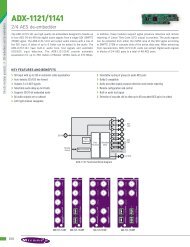

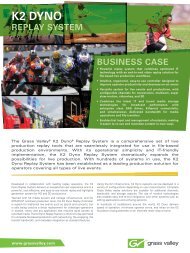
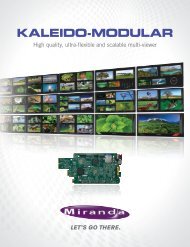
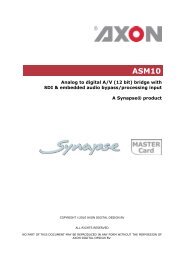


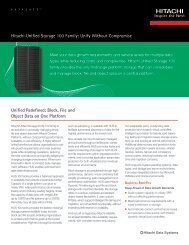



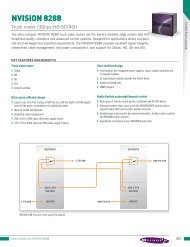
![Datasheet [pdf 653.2kb] - DK-Technologies](https://img.yumpu.com/38904183/1/184x260/datasheet-pdf-6532kb-dk-technologies.jpg?quality=85)